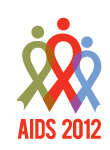 The experimental integrase inhibitor (INI) dolutegravir is comparable to the approved INI Isentress (raltegravir) for first-time HIV treatment takers, according to preliminary 48-week data from a Phase III clinical trial presented Thursday, July 26, at the XIX International AIDS Conference (AIDS 2012) in Washington, DC.
The experimental integrase inhibitor (INI) dolutegravir is comparable to the approved INI Isentress (raltegravir) for first-time HIV treatment takers, according to preliminary 48-week data from a Phase III clinical trial presented Thursday, July 26, at the XIX International AIDS Conference (AIDS 2012) in Washington, DC.
Dolutegravir, being developed by ViiV Healthcare in collaboration with Osaka, Japan-based Shionogi & Co., is expected to be the third INI approved for the treatment of HIV. Merck’s twice-daily Isentress (raltegravir) was approved in 2007 for treatment-experienced people living with HIV and again in 2009 for those starting therapy for the first time. Gilead’s elvitegravir is now being reviewed by the U.S. Food and Drug Administration; it is expected to be approved for once-daily use, in combination with a boosting agent (either ritonavir or cobicistat) and as a component of the “Quad” four-in-one fixed-dose combination tablet.
In clinical trials, dolutegravir has been used once daily, without the need for boosting, and is being explored in a fixed-dose combination tablet of its own—572-Trii, which also contains ViiV’s nucleoside analogs abacavir and lamivudine.
Encouraging data from a Phase II study (SPRING-1) evaluating dolutegravir as a component of first-line HIV treatment, were presented earlier this year at the 19th Conference on Retroviruses and Opportunistic Infections. At AIDS 2012, Francois Raffi, MD, of the University of Nantes in France and his colleagues provided delegates with a glimpse of the 48-week data from the pivotal Phase III SPRING-2 study conducted by ViiV and Shionogi.
SPRING-2 randomized 822 people on three continents—North America, Europe and Australia—to receive once-daily 50 mg dolutegravir or twice-daily 400 mg Isentress, plus a study investigator’s choice of either Truvada (tenofovir plus emtricitabine) or Epzicom (abacavir plus lamivudine). Most (85 percent) of the study volunteers were white men; roughly a quarter of the study volunteers had a pre-treatment viral load in excess of 100,000 copies and ten percent had a CD4 count below 200 cells.
At the week-48 mark, Raffi and his colleagues reported, 88 percent of those in the dolutegravir group had undetectable viral loads (below 50 copies), compared with 85 percent of those in the Isentress group. This difference, however, was not considered to be statistically significant, hence dolutegravir was classified as being “non-inferior”—no more or less effective—to Isentress.
Looking specifically at those with high pre-treatment viral loads, the researchers noted that 82 percent of those in the dolutegravir group, compared with 75 percent of those treated with Isentress, had undetectable HIV levels at week 48. Among those with lower pre-treatment viral loads, the efficacy was similar: 90 percent in the dolutegravir group, compared with 89 percent of those in the Isentress group, had undetectable HIV levels at week 48.
Approximately 5 percent of the dolutegravir-treated patients, compared with 8 percent of those who received Isentress, experienced bona fide virologic failure during the study. One patient in the Isentress group who experienced virologic failure, compared with no patients in the dolutegravir group, had evidence of HIV mutations conferring resistance to INIs.
As for adverse events, roughly 11 percent of patients in the dolutegravir group, compared with 14 percent in the Isentress group, discontinued treatment due to side effects. The most common side effects, in both groups, were nausea, diarrhea, headache and sinus/throat inflammation.
As for laboratory abnormalities, Raffi noted that patients in the Isentress group experienced slightly higher gains in total cholesterol and triglyceride levels. Blood-based creatinine levels were higher and estimated measurements of creatinine clearance were lower—both potential markers of kidney problems—were more likely to be documented in the dolutegravir group, though patients receiving dolutegravir were no more likely to experience clear-cut signs of kidney toxicity requiring therapy discontinuation.
“At week 48,” Raffi concluded, “once-daily dolutegravir was non-inferior to twice-daily raltegravir in treatment-naive HIV-infected subjects, with no evidence of emergent resistance to dolutegravir in virologic failure.” He added: “Dolutegravir plus NRTIs could be an option for first-line HIV treatment.”
Advertisement
Advertisement
Advertisement






Comments
Comments